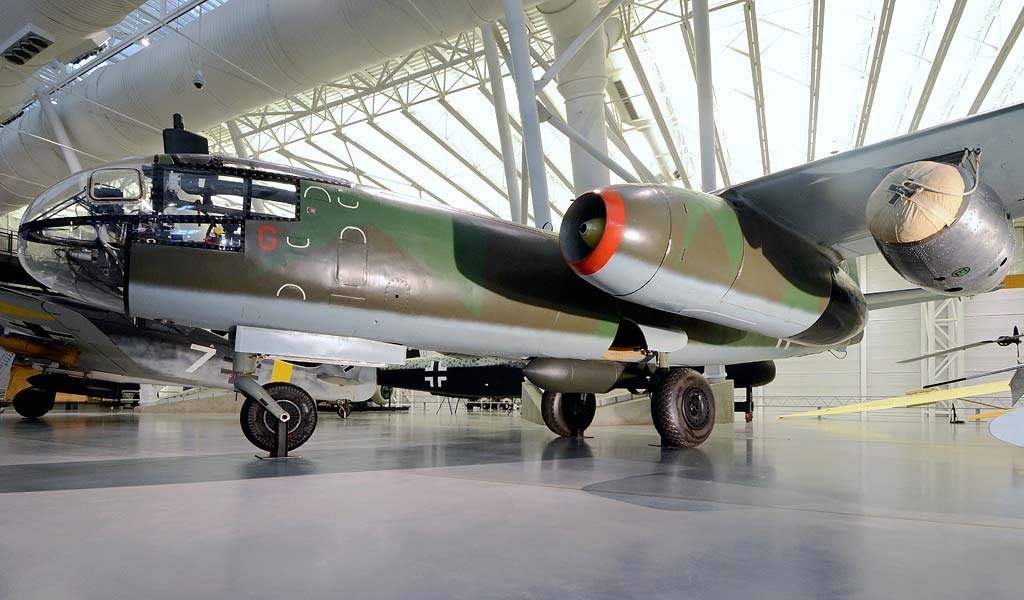The Arado Ar 234, a pioneering WWII German jet bomber, recognized for its high-speed capability, innovative jet propulsion, and reconnaissance roles.
The Arado Ar 234 was a groundbreaking aircraft in military aviation, marking a significant leap in technology during World War II as the first operational jet bomber.
History of the Development of the Arado Ar 234:
Developed in the midst of World War II, the Ar 234 was a response to Germany’s need for a high-speed bomber capable of evading enemy fighters and anti-aircraft fire. The Arado company, under the leadership of Walter Blume, initiated the project, focusing on harnessing the emerging jet propulsion technology to achieve unprecedented speed in bomber design.
The program, driven by the Luftwaffe’s demands for a fast reconnaissance aircraft and bomber, led to the development of a jet aircraft that could outperform existing propeller-driven bombers and fighters. The Ar 234 took its first flight on June 30, 1943. It did not receive a NATO nickname due to its development and use predating the establishment of NATO.
Design of the Arado Ar 234:
The Ar 234’s design was revolutionary. It featured a wingspan of 14.41 meters (47 feet 3 inches) and a length of 12.64 meters (41 feet 6 inches). The aircraft was powered by two or four Junkers Jumo 004 turbojet engines, a pioneering design in jet propulsion.
The design focused on minimizing drag for high-speed performance, resulting in a sleek, streamlined fuselage. Initially, it lacked conventional landing gear, using a detachable trolley for takeoff and landing skids, later replaced by tricycle landing gear.
Despite its advanced design, the Ar 234 faced challenges, including engine reliability issues and the limited availability of strategic materials. Nonetheless, it represented a significant step forward in aircraft design and technology.

Performance of the Arado Ar 234:
In terms of performance, the Ar 234 set new benchmarks. It could reach a top speed of approximately 740 km/h (460 mph) and had a service ceiling of 10,000 meters (32,800 feet). Its range was about 1,556 kilometers (967 miles).
When compared with Allied bombers like the B-17 Flying Fortress, the Ar 234 was significantly faster, providing a tactical advantage in evading enemy fighters and anti-aircraft defenses.
Military Use and Combat of the Arado Ar 234:
The Ar 234 was primarily used for reconnaissance and as a high-speed bomber. Its armament varied but typically included one or two 20 mm MG 151/20 cannons for defense, and it could carry a bomb load of up to 1,500 kg (3,300 lbs).
During its service in WWII, the Ar 234 conducted reconnaissance missions over the Allied front lines and bombing raids on strategic targets. Its high-speed capability allowed it to perform these missions with a lower risk of interception.
The Ar 234 faced competition from Allied fighters, but its speed often provided an edge. It did not see widespread use due to Germany’s deteriorating war situation and production limitations.
Post-war, the Ar 234 did not continue in service or see export to other countries. Its advanced design influenced post-war aircraft development, but it was quickly surpassed by newer jet aircraft.
The Arado Ar 234 stands as a landmark in the history of military aviation, representing a transition from propeller-driven to jet-powered aircraft in combat roles. Its innovative design and performance capabilities marked a significant, though brief, advancement in aerial warfare, showcasing the potential of jet propulsion in military aircraft. The Ar 234’s legacy is defined by its status as a pioneer in the jet age, leaving a lasting impact on the development of military aviation technology.
Back to the Bombers section.